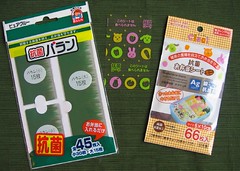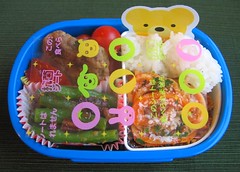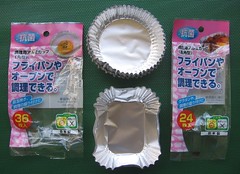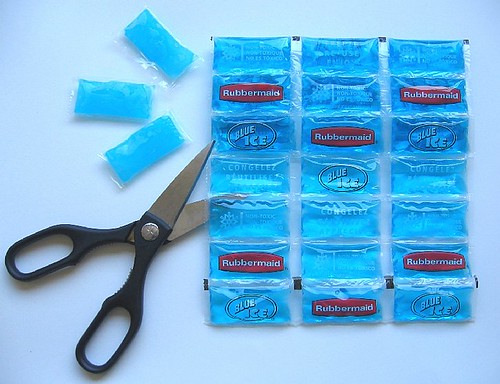Food safety for packed lunches
Tuesday, May 08, 2007
Posted by Biggie
May is Safety and Care month on The Daily Tiffin, so I wanted to share some pointers on keeping our packed lunches safe from spoiling. In my reading, the most interesting thing I found was modern research on foods with naturally antibacterial properties, which starts to explain traditional wisdom about food spoilage around the world. There are four main methods to keep your packed lunch safe:
- Incorporate food and products with antibacterial properties
- Keep it clean: Don't introduce bacteria into the lunch when packing
- Keep hot foods hot and cold foods cold, using thermal jars and cold packs
- Pack less perishable foods, especially in the summer
- Extra precautions for hot weather
- Handy foods for hot weather
- Ways to make dishes less perishable
- Incorporate food and products with antibacterial properties
Foods
Japanese bento cookbooks traditionally suggest packing foods with antibacterial properties in lunches in order to keep food from spoiling. Suggested foods include umeboshi (pickled plum), wasabi, ginger, karashi, salt, shiso, parsley and vinegar (i.e. making sushi rice, or putting an umeboshi or a tablespoon or two of rice vinegar in the cooking water when making rice). Some recommend wiping the inside of the bento box with a slice of ginger before packing. This is all fine and good for Japanese food, but that's not what I usually eat for lunch.
New USDA- and NSF-funded research on foods with antibacterial properties has yielded a number of foods that fit nicely in the world food lunchbox. The strongest antibacterial foods (killing all bacteria) are evidently garlic, onion, allspice and oregano. The second strongest (killing up to 80% of bacteria) include thyme, cinnamon, tarragon, cumin (and lemongrass). The third strongest (killing up to 75% of bacteria) are capsicums, including chilies and hot peppers. The fourth strongest (killing 25% of bacteria) include white and black pepper, ginger, anise seed, celery seed, and lemon or lime juice. Honey has antibacterial properties, and the dodecenal compound in cilantro/coriander (both fresh leaves and seeds) is evidently one of the stronger antibacterials as well. (see sources 1 - 3 below) - Keep it Clean: Don't introduce bacteria into the lunch when packing
Make sure your hands, food prep area, utensils and lunch containers are clean. When possible, use utensils (chopsticks, spoon, tongs, plastic wrap) to place, mold and arrange unwrapped food in your lunch container. If you're using a bento box with a rubber packing strip around the lid, be sure to periodically remove, wash and thoroughly dry the packing seal (and the groove in the lid). This will keep your box clean and ensure that the packing strip does not crack, which would leave you without a watertight seal. - Avoid the temperature danger zone with perishable foods
- The danger zone for bacteria growth is between 40 to 140F (4 to 60C, or room temperature). An extremely effective way to keep food safe until you eat it is to minimize the time food spends in this temperature zone (ideally less than three hours). The USDA's food safety page has a number of useful guidelines.
- Keep hot foods hot by using a pre-heated insulated thermos or food jar for liquids like curries, soups, stews, etc. To pre-heat, fill the thermos with hot water, let it stand for a minute or two, empty the thermos, and fill with hot food (close it quickly!). You can get little kid-sized 300ml food jars at superstores like Target or Walmart, bigger food jars, or even large thermal lunch jars with multiple containers inside (like the Mr. Bento or Ms. Bento) from online stores Amazon.com.
- Keep cold perishable foods cold by storing your lunch in a refrigerator (if available) or using insulated lunch bags or containers with cold gel packs. Western versions include insulated lunchboxes, the Laptop Lunchbox, Fit N Fresh containers; Japanese versions include insulated bento bags and picnic sets, bento boxes with a gel pack integrated into the lid, and insulated bento kits (with a thermal jar for the lid, two lidded side containers and an insulated carrying bag that you can put a gel pack into to carry hot and cold items at the same time). Thermal lunch jars can also be pre-chilled with ice water and used to pack chilled lunches. Flexible ice blankets are essentially a quilt of small reusable ice packs. They can be cut apart to produce many small ice packs, perfect for throwing into an insulated lunch bag (ice blankets are widely available at sporting stores, wholesale food stores and drugstores). Click on the photos below for a larger view.





- Pack less perishable foods,
especially in the summer. Rice becomes hard and unappetizing when refrigerated at low temperatures, so many Japanese forego refrigeration and cold packs for their rice-based bentos, choosing instead to incorporate antibacterial foods, pack foods that are less likely to spoil, and make their food less perishable through traditional cooking/packing methods.
Products
There are a number of bento products in Japan that have been treated with an antibacterial coating (i.e. flavorless compounds extracted from wasabi, etc.), designed to stave off microbial growth in packed lunches. These include aluminum food cups for cooking, plastic sheets that you place on the surface of your packed food, and food dividers that look like sushi grass. These must be touching the surface of the food to be effective. Not all food dividers and food cups are antibacterial; they must be marked "antibacterial". I bought the products below at local dollar stores and markets in San Francisco; click the photos for larger views with the "antibacterial" character indicated.
Antibacterial food dividers and bento sheets:


Antibacterial cups:

- Extra precautions for hot weather (for lunches to be eaten at room temperature)
- Japanese bento cookbooks instruct you to make sure all food in a packed lunch has been thoroughly heated through to the middle, so in hot weather scramble eggs until they are dry. Avoid raw or rare meat, poultry, fish or eggs. Avoid raw fillings for rice balls (make sure tarako fish eggs are grilled). Heat (then cool) even processed meats like sausages or hot dogs before packing to kill any bacteria that may have been introduced after processing.
- Avoid dairy products such as yogurt (especially when spooned out of a larger container).
- Avoid moist, liquidy foods.
- Avoid packing regular tofu in the same container as other foods as it sheds water and spoils easily.
- Avoid raw vegetables except cherry tomatoes.
- Avoid cut fruit as it spoils easily; pack whole fruit like a banana instead.
- Exercise caution with cooked rice, potatoes, grains and legumes (spice heavily, mix with antibacterial foods, dry thoroughly).
- Japanese bento cookbooks instruct you to make sure all food in a packed lunch has been thoroughly heated through to the middle, so in hot weather scramble eggs until they are dry. Avoid raw or rare meat, poultry, fish or eggs. Avoid raw fillings for rice balls (make sure tarako fish eggs are grilled). Heat (then cool) even processed meats like sausages or hot dogs before packing to kill any bacteria that may have been introduced after processing.
- Handy foods that survive summer heat
- Cherry tomatoes
- Rice that has been mixed with pickled vegetables, chopped pickled plum (umeboshi), or other foods with antibacterial properties
- Whole fruit
- Canned fruit that has been frozen in single-serving freezer containers (pack frozen to act as a cool pack)
- One-bite jellies that have been frozen (pack frozen to act as a cool pack)
- Juice boxes or bottled water that have been frozen (pack frozen to act as a cool pack)
- How to make dishes less perishable
- With moist, liquidy foods, first dry before packing (drain in a small colander or on paper towels) and pack in a paper food cup to contain any excess moisture.
- Spice foods more heavily than usual.
- If you're cooking or heating foods right before packing them in a sealed container (such as a bento box) to be eaten at room temperature, be sure to cool them first before packing. Once you've packed the lunch, allow it to cool further with its lid off to avoid condensation on the inside of the container. This also makes the box easier to open at lunchtime (an important point for preschoolers!)
- With moist, liquidy foods, first dry before packing (drain in a small colander or on paper towels) and pack in a paper food cup to contain any excess moisture.
Sources:
1) 1998 Cornell study on antibacterial spices: http://www.news.cornell.edu/Chronicle/98/3.5.98/spices.html
2) Cilantro article: http://www.eurekalert.org/pub_releases/2004-05/acs-is052404.php
3) CookWise, Shirley O. Corriher, 1997.
4) The New Professional Chef, Culinary Institute of America
5) USDA lunch food safety guidelines: http://www.cfsan.fda.gov/~dms/ftteats.html#lunch
6) USDA Freezing/Refrigerating time chart: http://www.cfsan.fda.gov/~dms/fttstore.html
7) Aijo Tappuri! Obento, Shufu no Tomo, 2007.
8) Obento Daijiten, Index Magazine, 2005.

If you like what we do here and would like support us in the Blogger's Choice Awards, vote here. Thanks for your support!
Are you interested in contributing to The Daily Tiffin? Drop us an email: blogmeeta@gmail.com. We look forward to hearing your ideas.
This Post was written by Biggie from Lunch in a Box.







WOW! Biggie, this is an incredible post. I have actually printed this out and added it to my folder in the kitchen so that I can easily refer to it whenever I want to. I never knew there were actually products with an anti-bacterial coating on them. Are these coatings natural and do not effect the food in any way?